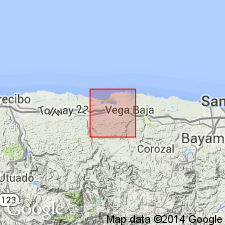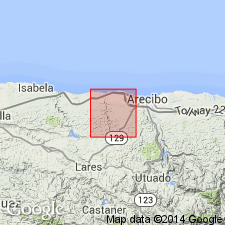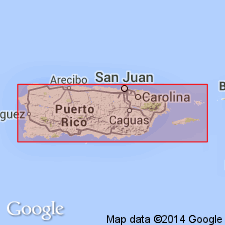
- Usage in publication:
-
- Almirante Sur sand member*
- Modifications:
-
- Original reference
- Dominant lithology:
-
- Sand
- AAPG geologic province:
-
- Caribbean region
Summary:
Almirante Sur sand member of Cibao formation. On both sides of the Rio Indio the lower tongue of the Rio Indio limestone member (new) is overlain by about 30 meters of sand herein named Almirante Sur sand member of Cibao formation. Basal 5 meters is exposed at type locality where the sand is [subrounded], coarse grained and pebbly. About 5 meters above base is persistent layer of more indurated pebbly sandstone forming prominent ledge in hills. Higher beds of member [consist of finer grained sand] and are well exposed on Route 645 north-northeast of type locality and on ridge just east of type locality. Sand is well exposed in Manati quadrangle (this report) in headwaters of Quebrada Arenas. West of Quebrada Arenas the sand member grades laterally into sandy, impure, marly chalk, indistinguishable from other parts of typical Cibao. East of the Rio Indio the Almirante Sur member grades into Rio Indio limestone member. On basis of preliminary study of fossils it is believed that the Cibao below the Quebrada Arenas limestone member is of Oligocene age. Age of Almirante Sur is Oligocene or Miocene.
Type locality: in Ciales quadrangle. Named for exposures in barrio Almirante Sur on Route 645 in Ciales quadrangle 450 meters south of Manati quadrangle and 1,550 meters west of eastern edge of Ciales quadrangle, Puerto Rico.
Source: US geologic names lexicon (USGS Bull. 1350, p. 19); supplemental information (in brackets) from GNU records (USGS DDS-6; Reston GNULEX).

- Usage in publication:
-
- Almirante Sur Sand Member*
- Modifications:
-
- Age modified
- AAPG geologic province:
-
- Caribbean region
Summary:
Age of the Cibao Formation is late Oligocene and early Miocene.
Source: GNU records (USGS DDS-6; Reston GNULEX).

- Usage in publication:
-
- Almirante Sur Sand Lentil*
- Modifications:
-
- Revised
Summary:
Name changed to Almirante Sur Sand Lentil of the Cibao Formation. Forms a lentil 30 to 40 m thick in the Rio Indio Limestone Member. Age is late Oligocene and (or) early Miocene.
Source: GNU records (USGS DDS-6; Reston GNULEX).

- Usage in publication:
-
- Almirante Sur Sand Lentil*
- Modifications:
-
- Overview
- AAPG geologic province:
-
- Caribbean region
Summary:
The Almirante Sur Sand Lentil of the Cibao Formation occurs on the north coast of Puerto Rico and consists of pebbly quartz sand and sandstone, and locally grades into glauconitic calcarenite.
Source: GNU records (USGS DDS-6; Reston GNULEX).
For more information, please contact Nancy Stamm, Geologic Names Committee Secretary.
Asterisk (*) indicates published by U.S. Geological Survey authors.
"No current usage" (†) implies that a name has been abandoned or has fallen into disuse. Former usage and, if known, replacement name given in parentheses ( ).
Slash (/) indicates name conflicts with nomenclatural guidelines (CSN, 1933; ACSN, 1961, 1970; NACSN, 1983, 2005, 2021). May be explained within brackets ([ ]).

